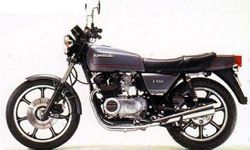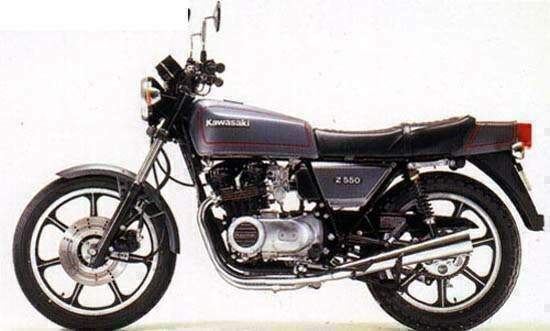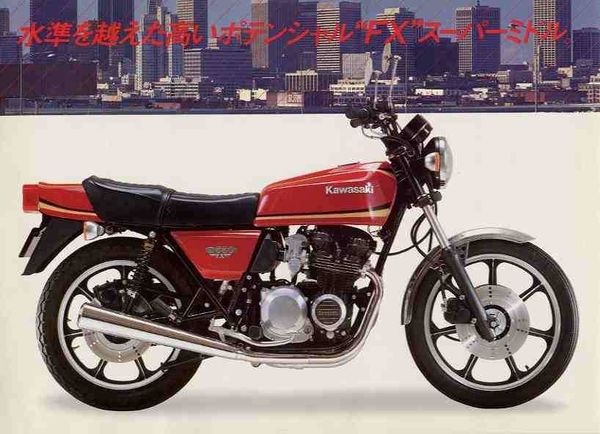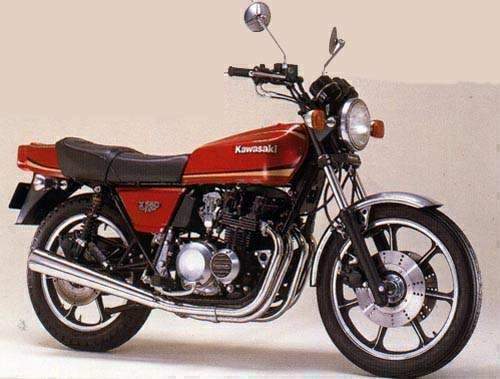Kawasaki Z550F
 |
|
| Kawasaki Z550 | |
| Manufacturer | |
|---|---|
| Also called | Z550F, Z 550 F, Z550 Sport, Z 550 Sport, Z550GT (reduced effect), Z 550 GT (reduced effect), Z550GT, Z 550 GT, Z550 LTD, Z 550 LTD, Z 550 |
| Production | 1979 |
| Engine | Four stroke, transverse four cylinder, DOHC, 2 valve per cylinder. |
| Compression ratio | 9.5:1 |
| Ignition | CDI |
| Transmission | 6 Speed |
| Suspension | Front: 36mm Telescopic forks Rear: Dual shock, 5-way preload |
| Brakes | Front: 2X 250mm disc Rear: Single disc |
| Front Tire | 3.25-19 |
| Rear Tire | 3.75-18 |
| Weight | 192 kg / 423 lbs (dry), |
| Recommended Oil | K-tech 10W-40 |
| Fuel Capacity | 14 Liters / 3.6 US gal |
| Manuals | Service Manual |
Engine[edit | edit source]
The engine was a Air cooled cooled Four stroke, transverse four cylinder, DOHC, 2 valve per cylinder.. The engine featured a 9.5:1 compression ratio.
Chassis[edit | edit source]
It came with a 3.25-19 front tire and a 3.75-18 rear tire. Stopping was achieved via 2X 250mm disc in the front and a Single disc in the rear. The front suspension was a 36mm Telescopic forks while the rear was equipped with a Dual shock, 5-way preload. The Z550F was fitted with a 14 Liters / 3.6 US gal fuel tank. The bike weighed just 192 kg / 423 lbs.
Photos[edit | edit source]
Overview[edit | edit source]
Kawasaki Z 550F
Kawasaki Z500,Z550 and GPz550
"Announced in 1978, the Z500 was directly related to the
Z650. The plain bearing four now had a hyvo cam-chain and six speed gearbox,
and displaced 497cc through downsized, 55 x 52.4mm dimensions. In most other
respects the whole bike was like the 650, only a bit smaller and lighter.
Sitting on a 55 inch wheelbase and wheighing about 430lb ready to ride, it
was an inch or two shorter and wheighed 60lb less than big bro.
From the start the 500 had three disc brakes and cast
wheels. Styling was best described as "understated", which is a kind of way
of saying fairly bland and unadventurous. Still, with 52bhp at 9000rpm it
went quite well, in a characteristically revvy Kawasaki way.
BIKE magazines' reporter suggested that the 500 would fill
the gap left by the much loved Honda CB400/4, but that didn't happen. It was
too expensive for one thing. Part of the little Hondas' secret was a
bargain-basement price (less than 900Pds when replaced by the 400T Dream
twin in 1978). Making due allowance for inflation, the Z500 really occupied
a different sector of the market. If your paying 1,250Pds, why not spend
400Pds more for a Z650, which wouldn't be too financially painful when
spread over a three year HP agreement?
A year later, the engine grew another 3mm in the bore to
become the Z550 (that's what it said on the side, although elsewhere it was
KZ550, because Kawasaki seemed to have adopted the American model
designation system). The standard roadster was joined by the LTD, with the
expected fat 130/90-16 rear wheel, stepped seat, high handlebars,
abbreviated mudguards and suspect handling.
1981 was the year Kawasaki pulled a rabbit out of their hat,
by launching the GPz series of sportbikes. (Incidentally the "z" was
supposed to be lower case in the early days, and only started to become a
"Z" in 1983, when the GPZ900R arrived on the scene.) Three GPz models were
unveiled, having been in development since 1978. At entry level the target
for the GPz550 was 120 mph and a 13 second standing quarter-mile. To boost
power from 54bhp to 58bhp at 9000rpm, the compression was raised to 10:1 and
the cams changed to give 0.7mm more valve lift ans 22 degrees longer
duration. In real life the tuned engine gave about 15% more power than the
ordinary four.
Tested by the American magazine MOTORCYCLIST, the result was
a 12.5 7 second/104mph standing quarter, which seemed incredible. Or
completely unbelievable, bearing in mind the claimed horsepower and 200kg
weight. British road tests achieved less spectacular results, as usual, but
the GPz550 was still substantially faster than the Z550, and effectively
offered the same performance as the original Z650.
Nothing had changed on the chassis front. The forks were now air-assisted, a
good-in-theory, bad in practice idea, because the legs weren't linked and
the volume of air inside was so small that it was difficult to set the
pressure at one side, let alone balance the two. "Infinite adjustability",
Kawasaki claimed. They weren't joking.
Style was the GPzs' secret of success. Bright red paintwork,
subtle graphics, black engine and exhausts, with polished alloy hightlites
on the wheel rims and cylinder head. Everybody seemed to like the new look,
and it was instantly identifiable, which is a marketing dream."
Classic Japanese Motorcycle Guide by ROD KER
| Make Model | Kawasaki Z 550F |
|---|---|
| Year | 1979 |
| Engine Type | Four stroke, transverse four cylinder, DOHC, 2 valve per cylinder. |
| Displacement | 553 cc / 33.7 cu-in |
| Bore X Stroke | 58 x 52.4 mm |
| Cooling System | Air cooled |
| Compression | 9.5:1 |
| Induction | 4x 22mm TK |
| Ignition | CDI |
| Starting | Electric |
| Max Power | 58 hp / 43.2 kW @ 9000 rpm |
| Max Torque | 35.5 ft-lb / 48.1 Nm @ 7000 rpm |
| Transmission | 6 Speed |
| Final Drive | Chain |
| Front Suspension | 36mm Telescopic forks |
| Front Wheel Travel | 173 mm / 6.8 in |
| Rear Suspension | Dual shock, 5-way preload |
| Rear Wheel Travel | 109 mm / 4.9 in |
| Front Brakes | 2X 250mm disc |
| Rear Brakes | Single disc |
| Front Tire | 3.25-19 |
| Rear Tire | 3.75-18 |
| Dry Weight | 192 kg / 423 lbs |
| Fuel Capacity | 14 Liters / 3.6 US gal |


